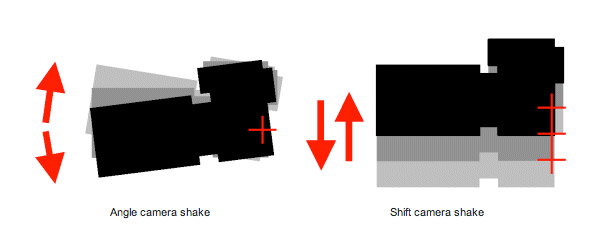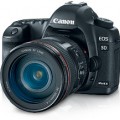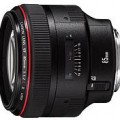Canon U.S.A. Introduces Three New EF and EF-S Lenses, including The First Camera Lens Featuring Hybrid Image Stabilization
Introducing the EF 100mm f/2.8L Macro IS USM, EF-S 15-85mm f/3.5-5.6 IS USM, and EF-S 18-135mm f/3.5-5.6 IS Lenses
Pre-Order the new Canon EF 100mm f/2.8L IS USM on Amazon.com
Lake Success, N.Y., September 1, 2009 – Canon U.S.A., Inc., a leader in digital imaging, continues its advancement of EOS lens technology with the introduction of three new EF and EF-S lenses – EF 100mm f/2.8L Macro IS USM, EF-S 15-85mm f/3.5-5.6 IS USM and the EF-S 18-135mm f/3.5-5.6 IS, lenses. The new EF 100mm f/2.8L Macro IS lens is the world’s first camera lens featuring Canon’s new Hybrid Image Stabilization (Hybrid IS) technology*, compensating for both angle camera shake and shift camera shake, up to four shutter speed steps. The EF 100mm f/2.8L Macro IS USM lens is compatible with all EOS cameras, while the EF-S 15-85mm and EF-S 18-135mm zoom lenses are designed specifically for Canon digital cameras that are compatible with EF-S lenses.**
EF 100mm f/2.8L Macro IS USM lens
The EF 100mm f/2.8L Macro IS USM lens could very well be the essential multipurpose lens for every camera bag due to its ability to capture sharp close-up images of small objects as well as beautiful portrait-length telephoto shots. The incorporation of Canon’s new Hybrid IS in this L-series macro lens allows it to compensate more effectively for camera shake during close-up shooting and marks a significant improvement for professionals and advanced amateurs utilizing macro photography for portrait, nature or wedding shoots.
New Hybrid IS Technology: Designed Especially for Macro Photography
The world’s first* optical image stabilizer for SLR cameras was introduced in the EF 75-300mm f/4-5.6 IS USM in 1995. Since then, Canon has made continual advancements in IS systems to enhance panning capability and improve compensation for camera shake. Now, in a move aimed at extending image stabilization to the macro realm, Canon introduces its Hybrid IS in the new EF 100mm f/2.8L Macro IS USM – another first for Canon and the world.
Conventional image stabilization technology is useful for reducing the effects of camera shake in non-macro shooting situations. When shooting handheld close-ups at 1x, however, camera shake makes it difficult to achieve acceptable results even with lenses incorporating conventional image stabilizers. Now, thanks to the Hybrid IS found in the EF 100mm f/2.8L Macro IS USM, Canon extends IS technology to the macro realm, making it easy to obtain clear handheld close-ups – a world first* and a definite advantage in environments where use of a tripod is not an option.
In order to combat the effects of camera shake in a macro lens, the IS system must be able to compensate for both angular camera shake and shift camera shake – problems that become more apparent as magnification increases. The effects of shift camera shake are rarely noticeable when shooting outside the macro realm, such as in landscape photography. But when shooting extreme close-ups, even the slightest amount of camera shake, either of the angular or shift variety, can adversely affect image quality.
In macro photography, shift camera shake and angular camera shake affect both the image formed on the sensor and the image shown in the viewfinder. This is especially relevant to handheld shooting at 1x, since the inability to properly compose and focus due to a shaky image in the viewfinder makes it extremely difficult to record sharp images.
Conventional image stabilizers of the type found in Canon IS lenses incorporate an angular velocity sensor (vibration gyro) to compensate for angular camera shake. Based on the amount of camera shake detected by the sensor, the IS system calculates the amount of blur on the image plane, after which lens elements in the IS are positioned to compensate for the shake. However, this type of image stabilizer can neither detect nor correct shift camera shake common to handheld macro photography.
The Hybrid IS includes an acceleration sensor in addition to the conventional angular velocity sensor (vibration gyro). Based on the amount of camera shake detected by the two sensors, a newly developed algorithm calculates the amount of blur on the image plane, after which lens elements in the IS are positioned to compensate for the two types of shake – a first in an interchangeable lens for SLR cameras and an excellent way to solve the problem of camera shake in macro photography.
Pricing and Availability
The Canon EF 100mm f/2.8L Macro IS USM is scheduled to be available at the end of September and sell at estimated retail prices of $1,049.00.

Lake Success, N.Y., September 1, 2009 – Canon U.S.A., Inc., a leader in digital imaging, continues its advancement of EOS lens technology with the introduction of three new EF and EF-S lenses – EF 100mm f/2.8L Macro IS USM, EF-S 15-85mm f/3.5-5.6 IS USM and the EF-S 18-135mm f/3.5-5.6 IS, lenses. The new EF 100mm f/2.8L Macro IS lens is the world’s first camera lens featuring Canon’s new Hybrid Image Stabilization (Hybrid IS) technology*, compensating for both angle camera shake and shift camera shake, up to four shutter speed steps. The EF 100mm f/2.8L Macro IS USM lens is compatible with all EOS cameras, while the EF-S 15-85mm and EF-S 18-135mm zoom lenses are designed specifically for Canon digital cameras that are compatible with EF-S lenses.**
EF 100mm f/2.8L Macro IS USM lens
The EF 100mm f/2.8L Macro IS USM lens could very well be the essential multipurpose lens for every camera bag due to its ability to capture sharp close-up images of small objects as well as beautiful portrait-length telephoto shots. The incorporation of Canon’s new Hybrid IS in this L-series macro lens allows it to compensate more effectively for camera shake during close-up shooting and marks a significant improvement for professionals and advanced amateurs utilizing macro photography for portrait, nature or wedding shoots.
New Hybrid IS Technology: Designed Especially for Macro Photography
The world’s first* optical image stabilizer for SLR cameras was introduced in the EF 75-300mm f/4-5.6 IS USM in 1995. Since then, Canon has made continual advancements in IS systems to enhance panning capability and improve compensation for camera shake. Now, in a move aimed at extending image stabilization to the macro realm, Canon introduces its Hybrid IS in the new EF 100mm f/2.8L Macro IS USM – another first for Canon and the world.
Conventional image stabilization technology is useful for reducing the effects of camera shake in non-macro shooting situations. When shooting handheld close-ups at 1x, however, camera shake makes it difficult to achieve acceptable results even with lenses incorporating conventional image stabilizers. Now, thanks to the Hybrid IS found in the EF 100mm f/2.8L Macro IS USM, Canon extends IS technology to the macro realm, making it easy to obtain clear handheld close-ups – a world first* and a definite advantage in environments where use of a tripod is not an option.
In order to combat the effects of camera shake in a macro lens, the IS system must be able to compensate for both angular camera shake and shift camera shake – problems that become more apparent as magnification increases. The effects of shift camera shake are rarely noticeable when shooting outside the macro realm, such as in landscape photography. But when shooting extreme close-ups, even the slightest amount of camera shake, either of the angular or shift variety, can adversely affect image quality.
In macro photography, shift camera shake and angular camera shake affect both the image formed on the sensor and the image shown in the viewfinder. This is especially relevant to handheld shooting at 1x, since the inability to properly compose and focus due to a shaky image in the viewfinder makes it extremely difficult to record sharp images.
Conventional image stabilizers of the type found in Canon IS lenses incorporate an angular velocity sensor (vibration gyro) to compensate for angular camera shake. Based on the amount of camera shake detected by the sensor, the IS system calculates the amount of blur on the image plane, after which lens elements in the IS are positioned to compensate for the shake. However, this type of image stabilizer can neither detect nor correct shift camera shake common to handheld macro photography.
The Hybrid IS includes an acceleration sensor in addition to the conventional angular velocity sensor (vibration gyro). Based on the amount of camera shake detected by the two sensors, a newly developed algorithm calculates the amount of blur on the image plane, after which lens elements in the IS are positioned to compensate for the two types of shake – a first in an interchangeable lens for SLR cameras and an excellent way to solve the problem of camera shake in macro photography.
Pricing and Availability
The Canon EF 100mm f/2.8L Macro IS USM is scheduled to be available at the end of September and sell at estimated retail prices of $1,049.00.
Pre-Order the new Canon EF 100mm f/2.8L IS USM on Amazon.com
AF speed and I hate reading charts and numbers, (they do not really tell me how a lens performs in the real world) I have finally found the time to do a quick and empirical autofocus speed test, using the lens coupled with a Canon EOS 5D Mark II
body. This quick animated gif may help people making up their minds and fork out the hard earned $ once and for all.
AF speed is indeed slower than “regular” Canon L Ultrasonic lenses, but fast enough for the average user and even faster than I actually thought… really! Considering that the autofocus on the Canon EOS 5D Mark II
it’s quite old and slow ( the camera shoots at only 3.9 frames per second) the quick test showed and confirmed that you can be assured you can achieve decent AF results, I would be very interested in seeing a similar test done with a Canon body with a much faster autofocus and fps like the 1DM3 or even with the new Canon 7D since its newly re-designed autofocus . The images were shots wide open at 1.2 by the way, so you know they have been shot at the shallowest DOF possibile. The SUV is approximately moving at 45 MPH and I used the center AF which is its only cross point. The animated Gif is slowed down a bit so you can see the focus is dead on.
I would strongly suggest you order and install the Canon Eg-S super precision focusing screen which only takes 2 minutes to install!







